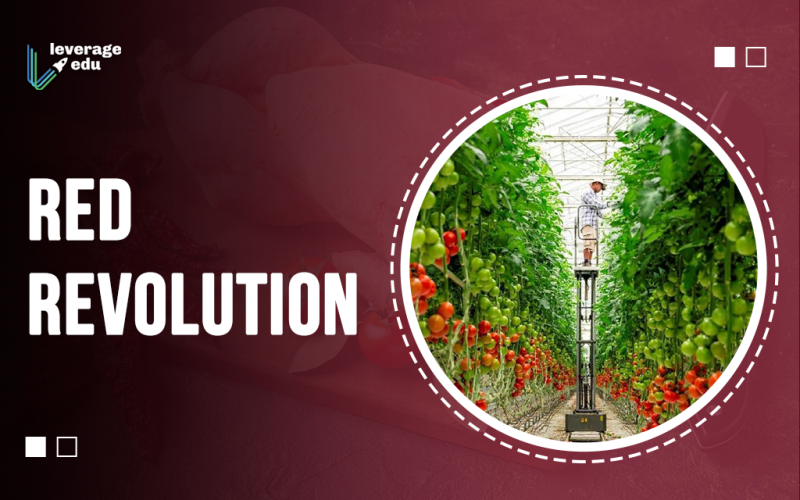India has witnessed numerous revolutions in the field of agriculture from the famous Green Revolution by M.S. Swaminathan to the White Revolution by Verghese Kurien. Famously called the Rainbow revolutions, these government-mandated reforms have led to growth and development in the production of a particular agricultural commodity or commodities by the use of technologically advanced equipment and inventions. In this blog, we will focus on the famous Red Revolution in India that led to the expansion of tomato and meat production!
Must Read: Food Security in India UPSC Notes
This Blog Includes:
What is the Red Revolution?
Red Revolution is the agricultural reform that led to a boost in the production of tomatoes and meat in India. Vishal Tewari is regarded as the father of the Red Revolution in the country. This major boost in the farming and poultry sector took place in the 1980s. Between 1980 and 2008, India’s agricultural growth expanded beyond the Northern grain belt, led primarily by rapid production growth in horticulture (tomato) and livestock products (meat). India’s agricultural output grew, on average, by 3.1% per year.
This growth was due more to an increase in productivity than an increase in resources; efficiency and technical changes accounted for 66 per cent of that growth, while more conventional inputs (land, labour, capital, and materials) accounted for 34 per cent. Increased investments since the 1980s in agricultural research have yielded a great impact on productivity.
Also Read: Economics for UPSC 2021
Tomato Production
Tomato is one of the three most important crops under the Indian Government’s “top” priority list of horticulture crops along with Onions and Potatoes. The total area under tomato cultivation in India is about 4.97 lakh hectares, about 7.3% of the total cropped land under vegetables. India is ranked 3rd after China and the US as far as the production of tomatoes is concerned. India has experienced a considerable increase in the production of tomatoes over the years under the recognized ‘Red Revolution’. Andhra Pradesh has the highest tomato production followed by Maharashtra and Odisha.
In India, the growth of tomatoes is mainly in two seasons across the country, from June to September (Kharif season) and October to February (Rabi season), it might be throughout the year in some regions.
Impact of Red Revolution: Tomato Production
Under the Red Revolution, new and more resilient varieties of tomatoes were adopted. The tomato variety Pusa Ruby (IARI, New Delhi) was one of the earliest and most prominent varieties used for both the fresh market and the processing industry in India. Public institutions assisted in breeding varieties more suited for processing than the ones grown by the farmers. Later, farmers shifted to commercial fresh market hybrids due to their high-yielding potential. In general, greater usage of pesticides and advanced irrigation facilities have aided agricultural production.
Moreover, the supply chains and coming up of wholesale markets or “mandis” under the Red Revolution, have accelerated both the profitability of farmers and the level of outcome. There are still certain challenges faced by the market. These highly perishable goods are still prone to viruses and infections that can easily destroy crop production Better infrastructure in the market is also a must along with the elimination of communication gaps between different stakeholders like farmers, traders, retailers and more.
Also Read: Public Administration in India UPSC Notes
Meat Production
Meat production in India is estimated at 6.3 million tons annually which is ranked 5th in the world in terms of volume. India is responsible for 3% of the total meat in the world. The nation has the world’s largest population of livestock at about 515 million. Uttar Pradesh is the largest meat producer, second by Andhra Pradesh, then by West Bengal and Maharashtra. Under the Red Revolution, the average annual meat tonnage rose by 2.9 per cent from 1980-2008. Sustained economic growth, urbanization, improvement in transportation and cold storage facilities and the rise of supermarkets, both the demand and supply for animal-based products especially meat have skyrocketed.
Impact of Red Revolution: Meat Production
The government has taken certain policies in order to boost the meat production in the country like increasing the export of poultry products like meat, allowing more FDI, keeping a check on the quality standards, and contamination of meat. The government has launched a comprehensive scheme for the modernization of slaughterhouses across the country. The Agricultural and Processed Food Products Export Development Authority has approved 70 integrated abattoirs, slaughterhouses, and meat processing plants across the country. More research is conducted to have a better quality of meat, and more focus on enhanced facilities of storage and slaughterhouses As an implication of the Red Revolution, the quality and quantity of meat production has become better.
Even though challenges like outbreaks of infections among livestock, greenhouse gas emissions by the herbivore animals as well as lack of surveillance and unhygienic conditions of the slaughterhouses increase the health-related and occupational hazards. Greater regulation of the meat market, organised meat industry, and research on upgraded cross-breeding is necessitated to continue the Red Revolution.
Related Blogs
- Pink Revolution
- Silver Revolution
- Black Revolution
- Grey Revolution
- Golden Revolution
- Blue Revolution
- Yellow Revolution
To read more interesting blogs, check the links given below.
This is all you must know about the Red Revolution in India. The rainbow revolutions in India have led to an increase in the economic value of the primary sector, enhanced food security, simplified the production process scientifically and enhanced the livelihood of thousands of Indians. To get better guidance on your academic and professional journey abroad, connect with our Leverage Edu experts.

 One app for all your study abroad needs
One app for all your study abroad needs
























 45,000+ students trusted us with their dreams. Take the first step today!
45,000+ students trusted us with their dreams. Take the first step today!


